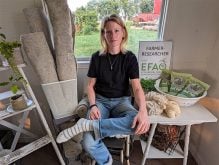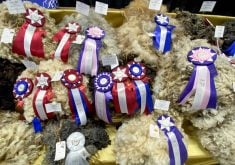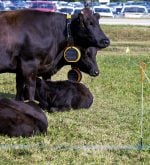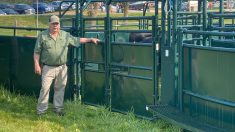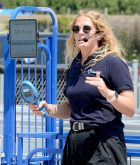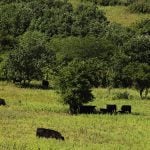The 2025 Ontario DLF Pasture Award was presented to Gayla Bonham-Carter and Scott Bade, of Footflats Farm on Amherst Island.
Why it matters: The award recognizes exceptional pasture management, including strategies that maximize production per acre.
Four years ago, the couple bought the sheep flock from Bonham-Carter’s grandparents, 2021 Outstanding Shepherd winners Mark Ritchie and Cherry Allen, and took over the family’s 180-acre Footflats Farm.
“It’s a lot of marginal land, high clay soil, so we have a lot of opportunity to lease pasture cheaply,” said Bonham-Carter, who rents approximately 800 acres on the island. “As long as we’re willing to put in the work to fence everything up and get a sheep out there.”
They lamb out 1,200 ewes in a low-input operation by synchronizing lambing with grass growth, using electric fencing systems, a Prattley mobile handling system, and robust New Zealand Coopworth genetics to produce “easy-care ewes” that flourish in harsh winters and dry summers.
Read Also

From WhatsApp to the world
Simple technology and a new approach are making it easier to connect farmers and research in Kenya.
The Prattley mobile handling system enables a single person to handle, sort, dock, wean, drench, and vaccinate on pasture without needing additional labour.
“It doesn’t matter if you use it four kilometres away from home or 100 yards from the barn, we can yard them and sort them and drench them,” she said. “We get a lot of use out of it, and it opens up a lot of grazing opportunities we wouldn’t have had otherwise.”
Initially, the flock was a mix of half Coopworth, a quarter Border Cheviot and Romanov. It is now transitioning to 100 per cent Coopworth to take advantage of the breed’s forgeability, fertility, natural parasite resistance, easy lambing, and good pasture lamb percentage traits.
“Worm resistance is something that we’re really interested in, because it means less drenching, and hopefully we can get onto that feed a little sooner,” she explained. “We still have to manage carefully, but it’s just another tool in the toolkit.”
Bonham-Carter mentioned that the Nikau Coopworth genetics promote strong maternal traits and reliable twin births, which is preferable since triplets often struggle in pasture systems and are more vulnerable to parasites and predators. Besides genetics, Bonham-Carter said they have added cattle into the grazing system to reduce parasite loads and provide fresh feed for lambs after weaning.
They are looking to incorporate some terminal sires to add diversity to the lambs and recently purchased a few Texel sheep from Bill McCutcheon, a producer and lamb merchandiser for Ontario Lamb Marketing Inc.
Footflats Farm maintains a small flock of purebred, non-registered Border Cheviots, using the rams to breed first-time-lambing ewes, which produce smaller lambs with good birth vigour. The Border Cheviot lambs develop into small, well-muscled carcasses that are well-suited for ethnic markets, with Footflats Farm focusing on the light lamb market from December to February.
“We target the light lamb market. So, lambs at about 70 pounds is what we go for,” she explained. “They are a medium-sized sheep. They’re certainly not a large sheep, which is great for feed conversion.”
The award was sponsored by DLF, the Ontario Forage Council, and the Ontario Sheep Farmers.






